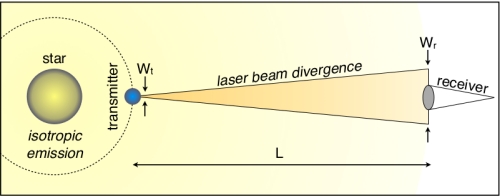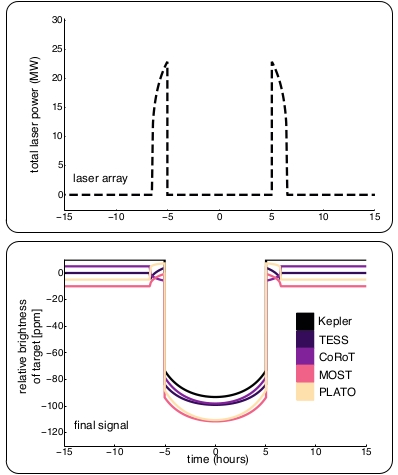David Kipping and Alex Teachey have a new paper out on the possibility of ‘cloaking’ a planetary signature. The researchers, both at Columbia University, make the case that any civilization anxious to conceal its existence — for whatever reason — would surely become aware that all stars lying along its ecliptic plane would see transits of the home world, just as its own scientists pursued transit studies of planets around other stars. And it turns out there are ways to make sure this signal is masked by adjusting the shape of the planet’s transit light curves.
Now this is a fascinating scenario as presented by the head of the Hunt for Exomoons with Kepler, whose business it is to know about the slightest of variations in light curves because they may contain information about exomoons or rings. Thus Kipping is a natural to look into the artificial manipulation of light curves, a study with definite SETI implications. Because methods like these work in two directions — a civilization that does want to communicate could also alter its light curve in ways that would be unambiguously artificial. Today I want to focus on the latter idea, reserving cloaking methods for tomorrow’s post.
This veers into the METI debate, but that’s not my purpose. Messaging to Extraterrestrial Intelligence is highly controversial, triggering arguments in these pages for the last decade. But let’s hold METI at one remove. The paper, delightfully titled “A Cloaking Device for Transiting Planets,” allows us to imagine how the manipulation of transit signatures could change a distant planet’s visibility. We may well decide not to brighten the Earth’s visibility through intentional transmissions, while understanding that an extraterrestrial culture might choose differently. Knowing what is possible by way of cloaking or enhancing a planetary signature, then, gives us plenty of food for thought for SETI as we consider what might turn up in our data.
Modifying the Light Curve
Here’s the notion in a nutshell, as drawn from the paper.

Image: Figure 1. Illustration (not to scale) of the transit cloaking/broadcasting device. A laser beam (orange) is fired from the night side of inhabited planet (blue) towards a target star whilst the planet appears to transit the star, as seen from the receiver. In the case of the Earth, the planet could be cloaked by generating an inverse transit-like signal of peak power 60 MW. Credit: Kipping and Teachey.
Controlled laser emissions are the key, effectively distorting the shape of a transit light curve. Just how this could be done is something we’ll discuss in the next post. But to begin, let’s think about how visible we are to any advanced civilization studying us. Forget about our radio and television signature, which is infinitesimal, and focus instead on the things we are doing right now to study other stars. I often write about transmission spectroscopy, which is how we search for the constituent molecules in a planetary atmosphere. The transiting planet, as it moves in front of its host star (as seen by our instruments) is bathed in the star’s light, its atmosphere providing a particular ‘overlay’ to the star’s spectrum.
We’ll use the method to look for biosignatures as we refine it for smaller and smaller worlds, but we’ve already seen how successfully we can examine the atmospheres of ‘hot Jupiters’ like HD 189733b. A sufficiently capable civilization able to see our world transiting should be able to pick up the cluster of biosignatures that would identify the Earth as a living world. There have been proposals to look for atmospheric pollutants produced by industrial activity as a part of future SETI practice, and such activity could indeed become visible, though the idea of widespread pollution lasting for millennia seems a stretch. Understanding the damage it caused, surely the culture in question would either solve its pollution problems or else succumb to them.
Let’s not forget the recent flurry of interest in the unusual star KIC 8462852. Here we’re looking at what could well be a natural phenomenon in the form of clouds of comets, but could possibly be evidence of artificial megastructures throwing highly distinctive light curves. We have much work ahead on KIC 8462852, so I only bring it up to suggest that there are many ways an intelligent species might make itself visible whether its intent was to do so or not.
Turning Transits into ‘Broadcasts’
Scientists as diverse as Ronald Bracewell, Richard Carrigan, Michael Papagiannis and Robert Freitas have studied the possibilities of such detections, with Carrigan most prominently identified with the search for Dyson spheres, swarms of energy collectors that surround a star to feed its colossal energies to a growing Type II civilization. And back in 2005, Luc Arnold (now at Aix Marseille Université) suggested that a civilization wanting to be known could resort to deliberate signaling by building a particular kind of geometric megastructure, one that when viewed in a transit would all but shout, through its distinctive light curve, that it was artificial.
Kipping and Teachey are, as you would imagine, well aware of Arnold’s work, and argue that lasers offer far more practical methods. From the paper:
Whilst any number of artificial transit profiles can be created with lasers, one ideally seeks a profile which is both energy efficient and unambiguously artificial. Producing upward spikes in-transit might seem like an obvious suggestion, but star spot crossings produce these forms with complex and information rich signatures (e.g. see Beky et al. 2014). Here, we argue that cloaking the ingress/egress of a transit, but leaving the main transit undistorted, would be a highly effective strategy since no known natural phenomenon is likely to produce such an effect.

Image: Figure 6 from the paper, highlighting broadcasting rather than cloaking. Top: The power profile of a laser array designed to broadcast the Earth. An array of lasers producing a peak power of ? 20 MW for approximately 15 minutes nullifies the transit ingress and egress. Bottom: The resulting light curves as viewed by different broadband optical photometers. The observed impact parameter would be complex infinity, for which a normal light curve fit would be unable to explain and thus indicating the presence of artificial transit manipulation.
A monochromatic laser emission could be spotted in a transit survey (and could be searched for in Kepler data), with follow-up spectroscopy confirming the artificial nature of the transmission. Kipping and Teachey also note what James and Dominic Benford recently pointed out in their paper on SETI efforts at KIC 8462852 — a beamed signal of whatever kind could carry information, so that in addition to identifying the presence of a technological culture, the beam could attempt more detailed communication (see SETI: Power Beaming in Context).
I’ve focused in on broadcasting via transit light curve alteration because, as the paper argues, it is the most efficient use of these techniques as compared to cloaking, which I’ll describe tomorrow. I’m trying to stay out of the METI weeds here — this is not an argument in favor of identifying the Earth to ETI. Rather, it is an argument that other civilizations may use such methods, and thus this paper shows us a signature we should add to our catalog.
And it has this further implication: If a civilization did choose to broadcast its existence through these methods, it would probably choose the shortest period planet in its solar system to carry the message. The choice is obvious, as the paper notes, for this produces “a higher duty cycle of distorted events,” making the detection all the more obvious. “We therefore suggest that any survey in archival data should not be limited to rocky planets in the habitable-zone of their host star.” An excellent reminder not to succumb to easy assumptions!
Tomorrow I’ll return to the Kipping and Teachey paper with a look at cloaking possibilities. The paper is “A Cloaking Device for Transiting Planets,” accepted by Monthly Notices of the Royal Astronomical Society (preprint).



Full cloaking is not a viable option if we want to “hide” the Earth transit as radial velocity measurements (and potentially direct imaging) will alert any observers to an anomaly.
Partial or bio-cloaking would seem to be the major benefit of this technique.
If lasers could be used effectively to cloak or broadcast a transit they could just as easily be used to broadcast a “reverse” transit or any other anomalous/intelligent signature at any time. I am not sure why you would need to coincide such a broadcast with a transit for detection by observers.
I think the idea is that ETI would be looking for transits in their exoplanet programs. Broadcasts not coinciding with transits would not be noticed, they would disappear in the noise.
We may ALREADY have a candidate! EPIC 211152484, with an orbital period of less than a day. Google “Ultra Short Period Planets in K2: SuPerPig results for campaigns 0-5. “>>>we report on EPIC211152484 which has intermittent transits that are only visible during about half of the observing campaign…” i.e. LIKE KIC12557548, but WITHOUT the debris “comet tail”! TWO OBVIOUS QUESTIONS: ONE: Have Kipping and Teachey looked at these lightcurves yet? And, TWO, Could you COMPLETELY CONCEAL a transit with lasers?
I find the idea of hiding a planet with the a fore mentioned laser proposal of dubious utility. You would only be hiding form relatively technologically backward civilizations such as ours. More advanced civilizations (and potentially much more threatening) can/could probably image planets directly and not have to wait for transits.
As to the later idea of signaling, it seems extremely non-optimal to try to shape the transit signal. If the laser is strong enough to be detected why not just signal directly as in proposed by Optical SETI? However I do see a third scenario here, and one in which data could be hiding in existing Kepler observations. Look for extremely short peaks across many EM bands at exactly the half way points between occlusion/eclipse pairs. In other words the planet would shine its LASER/MASER/RADIO/X-RAY/GAMA_RAY beacon exactly following it orbital trajectory (and possibly trailing trajectory). This then would produce peaks exactly half way between when the planet transits its sun and when it is eclipsed by its sun. Of course it would have to shine off its ecliptic plane as well, perhaps scanning stars as they are exactly aligned (horizontally) with the middle of transit/eclipse pairs. Or it could have an extremely shaped beam like a fan almost 180 degrees in coverage, but only in an extremely narrow vertical slice. This then wouldn’t even have to rely on us observing transits (when we are perhaps not in a direct transit line), but still know the orbital period of the planet.
Alien societies would likely also have taxpayers and politicians who would balk at the colossal waste of resources such a scheme would involve.
Won’t there need to be a lot of lasers to transmit to a number of target stars to modify the transit for all of them in the sky that can see the transit? Also, as lasers are monochromatic, the transit will only be modulated in a narrow wavelength. This might be more of a dead giveaway when observing the transit spectroscopically.
When we get to cloaking in the next installment, there is going to be a problem for civs that already have expanded to other stars, as the transits will look different depending on the observer and thus a giveaway that cloaking is being attempted.
A first look at this strikes me as expensive and ineffective as a cloaking mechanism. Let’s consider a few likely problems:
1. It only works for Earthly observers. The polychromatic “laser” has to run continuously to cloak from all observers (known and unknown) using transit techniques.
2. Transit detection is not limited to planets passing in front of the star. We can also track light curves as planets sweep out their orbit, and especially the sharp transition when the planet goes behind the start.
3. Per point 2, better instruments wouldn’t even require transits for a positive detection. So the cloaking is even less effective.
Offhand I think a better solution is one with (mostly) passive bodies in the same orbit, one leading and one trailing by 90 degrees. They would reflect and block stellar light in a manner in keeping with the phases of the planet throughout its orbit, including IR radiation off the back that would mimic the planet’s night side emission.
Details would need to be calculated to determine the bodies shape and structure, and any dynamic rotation, to exactly match (compensate) for the planetary emission (or lack of it). It is still not a universal solution but better. It’s also mostly passive and thus far less expensive and requires less maintenance.
Tomorrow’s post is so good, we’re already commenting on it. ;-)
Yes, clearly we’re all peering into the future!
“If a civilization did choose to broadcast its existence through these methods, it would probably choose the shortest period planet in its solar system to carry the message. ”
You can combine a large solar array and lasers to broadcast without any associated planet. Place a number of these in orbits close to the star and you could broadcast to a large range of angles, not just targets along the ecliptic.
We are in the “infancy” of observing exoplanets and our current focus is observing “transit dips” to identify planets. As we mature, with more powerful scopes and observation platforms, we will have mapped most nearby planets with a variety of techniques.
Transit observation may be something we do for only a limited time. What we will be observing and what techniques we will be using in 100-200 years time is hard to foresee. What civilisations a million years advanced will be observing is impossible to know.
Great post, very interesting method of altering transit signature to broadcast presence
It would be interesting to know if the authors of this Paper employed Robertson-Walker metric at any stage. If they did it would be a safer turf with variables taken as commoving coordinates (the same is fixed once and for all for any Galaxy). If they didn’t….then the commoving volume would be dramatically affected by the look back time.
Supposing an observer is stationed at a commoving coordinate and the source is at zero, it also implies that in the end observer can also ‘be’ at zero, too, due to isotropic S-T.
I had a similar idea a few years ago; a Dyson swarm or similar megastructure could hide its existence from thousands of nearby stars using phased-array emitters. This would require a tiny fraction of the intercepted light. Call it a peaceful application of the Nicoll-Dyson laser concept.
A very interesting concept indeed, but, with a BIG CAVAET! Assuming the Dyson Swarm COMPLETELY ENSHROUDS THE STAR, Murphy’s Law is bound to make its presence known NO MATTER HOW ADVANCED THE CIVILIZATION IS! In other words,breakdowns will happen in the swarm somewhere, ALMOST ALL OF THE TIME! If the civilization is starting to CRUMBLE, this situation could be GREATLY ENHANCED! Case in point: Could the bizzare lightcurves of KIC8462852 be explained by EXACTLY THIS SITUATION?
David Kipping and Alex Teachy: Is there ANY INDICATION in the Kepler data that the NEWLY DISCOVERED(via radial velocity) that Kepler 20g(MASS:~20Me, ORBITAL PERIOD: ~34 days)has been cloaked? RSVP!
A Chance to See Moons Around the Exoplanet Beta Pic B in 2017
By Phil Plait
I don’t usually write about observations that haven’t been done yet, but this is so interesting I wanted to tell y’all about it. Next year, due to a quirk of geometry, it’ll be possible for astronomers to search for moons or other debris around the exoplanet Beta Pictoris b. They won’t be able to see the planet itself, but if there’s stuff around, that might be detectable.
The star in question is Beta Pictoris, which is about 60 light-years away (that’s relatively close). It’s more massive, hotter, and brighter than the Sun. It’s also considerably younger: It’s about 25 million years old, while our star is more than 4.5 billion years in age.
Full article here:
http://www.slate.com/blogs/bad_astronomy/2016/08/11/moons_orbiting_the_exoplanet_beta_pic_b_may_be_visible_in_2017.html